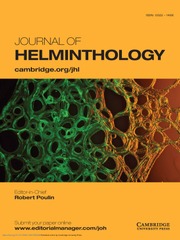No CrossRef data available.
Article contents
Linalyl acetate against larvae of Haemonchus spp. and Trichostrongylus spp. that affects ruminants: considerations about the hormetic effect
Published online by Cambridge University Press: 28 October 2024
Abstract
Active components from plants are an alternative therapy to parasite control, addressing the widespread multidrug resistance populations. Linalyl acetate (LA), an ester abundantly found in plants of the genus Lavandula, was tested in vitro against third-stage larvae (L3) of Haemonchus spp. and Trichostrongylus spp. using the larval migration test at 0.89, 2.24, 4.47, 8.95, 17.9, 35.8, 71.6, and 143.2 mg/ml. After an initial incubation of 18 h, the total content of each tube was transferred to a 24-well plate that allowed active L3 to migrate through a nylon mesh (second incubation). Although LA exhibited 100% efficacy in reducing larval migration at 8.95 and 17.9 mg/ml, it showed reduced activity (5%) at 143.2 mg/ml. The data revealed a hormetic biphasic response characterised by an inverted U-shaped concentration-response curve. While hormesis has been previously documented in insecticidal and allelopathic contexts, this study reports the occurrence of hormesis induced by a phytochemical component against two species of nematodes for the first time. This distinctive stimulation-and-inhibition effect should be considered when selecting new compounds for preclinical testing.
- Type
- Research Paper
- Information
- Copyright
- © The Author(s), 2024. Published by Cambridge University Press


